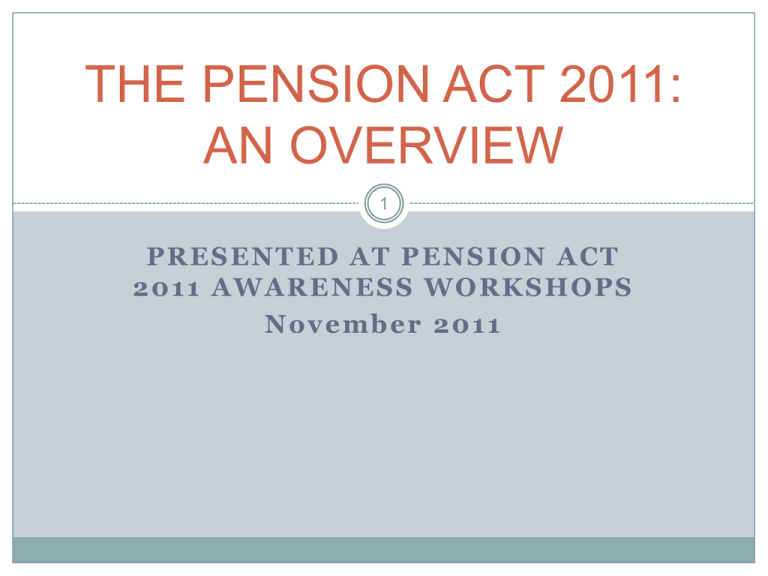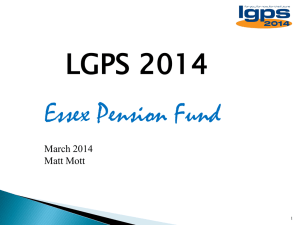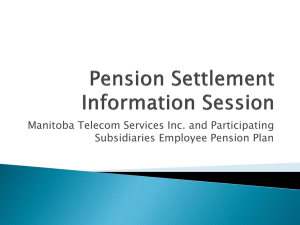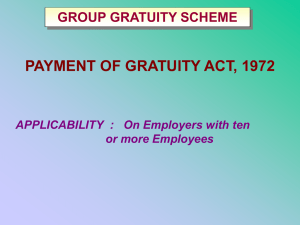TH PENSION ACT 2011
advertisement

THE PENSION ACT 2011: AN OVERVIEW 1 PRESENTED AT PENSION ACT 2011 AWARENESS WORKSHOPS November 2011 OUTLINE 2 1. Status of the Act 2. Objective 3. Application & Scope 4. Key Issues Status 3 The Pension Act 2011 was: Enacted by Parliament on 1st March 2011. Assented to by the President of the Republic of Malawi on 1st April 2011. Gazetted on 8th April 2011. Came into force on 1st June 2011 except for Section 13 of the Act . OBJECTIVES 4 The objectives of the Act are to: (a) Ensure that every employer to which the Act applies provides pension for every person employed by that employer; (b) Ensure that every employee in Malawi receives retirement and supplementary benefits as and when due; (c) Promote the safety, soundness and prudent management of pension funds that provide retirement and death benefits to members and beneficiaries; and (d) Foster agglomeration of national savings in support of economic growth and development of the country APPLICATION 5 Applies to all employers and employees in Malawi unless expressly exempted under Section 2(1) by the Minister with approval from Cabinet. COVERAGE: EXEMPTIONS 6 a. Section 10(1) of the Act: Threshold prescribed by the Minister (Upper limit) Section 10 (2) of the Act subject to S.10 (2)(b): monthly salary of K 10, 000 & below and less than five employees ; or c. Section 10 (3) of the Act: Seasonal workers, tenants, domestic workers, expatriates on valid TEP, MPs in their capacity as such; or d. Section 86 (3) of the Act for those already on pension: three or less than three years to retirement date. b. Employment Act 7 Kindly note S. 10 (4) of the Act that all employees and employers exempted under Section 10 (2) and (3) are governed under the provisions of the Employment Act. In a nutshell, on termination of employment the employee must be given gratuity . Key Issues 8 Creates a mandatory pension scheme. Obliges an employer to provide a life insurance cover of one times the annual pensionable emoluments of the employee. 3. Establishes a National Pension Scheme comprising of a National Pension Fund and other pension funds licensed under the Act. 4. Prescribes minimum contribution rates: • 10% for the employer. the employer at liberty to put at 7.5% from the date of commencement until 31 December 2012. • 5% for the employee; 1. 2. Key Issues cont.. 9 • Employer and employee can agree to adjust the contributions upwards; • Allows for voluntary contribution in addition to the total contribution provided its within the threshold in S. 10(1). • No downward adjustment for employers contributing at higher rates than the min contribution rates under the Act before 1st June 2011. (S. 86 (1)) • Again no downward adjustments for insurance cover if it was higher than the minimums in the Act . (S. 86 (1)) Key Issues cont.. 10 4. Allows for transferability of pension benefits. S.14 • At least once in every two years; • No need to give reasons; • Costs of transfer to be on the employee • Employer to only bear costs for administration as the employer would have paid in the employer ‘s arrangement. 5. Provides for portability of pension benefits. S. 44: Where an employee switches employment Key Issues cont.. 11 6. Requires registration of all pension schemes by the Registrar. (S. 16 (1) a) The Registrar will register a restricted fund if : the fund rules provide that the fund exists solely to provide for pensions or annuities; The fund rules provide for specific rates and times at which contributions must be made; The trustee of the fund is licensed and fund rules guarantee that trustee’s powers will not be subjected to direction by any person. S. 43 Key Issues cont.. 12 The fund rules provide that a trustee will not be paid any fee out of the fund assets for acting as trustee. However an independent trustee may be paid out of the scheme assets provided the Registrar determines that the fee is reasonable. b) For unrestricted funds the conditions for registration are stipulated in S. 18. generally the same save for payment of trustees. c) S. 19 stipulates conditions for registration of an umbrella fund. d) Upon registration, the trustee or operator of the pension fund or umbrella fund must notify the Commissioner of Taxes. S. 20 Key Issues cont.. 13 The fund assets are held by a custodian 7. Provides for the equal representation rule in case of restricted funds trustees. (S. 26 (1) This includes employers save for circumstances prescribed by the Registrar. S. 43 (2) (d) Fund rules must not subject a decision of the trustee to approval or consent from the employer unless the decision touches on increasing benefits or rates of benefits or costs to the employer or costs of administration of the fund Key Issues cont.. 14 8. Creates rights for members and a member has a right to: a. Fund information which is defined to include: • Fund investment strategy • Investment performance and financial position • Fees and charges payable by fund members • Rights and entitlements of members or beneficiaries under fund rules • Obligations of member to pay contributions • Obligations of employer to pay contributions Key Issues cont.. 15 b. request information about the fund or his entitlements in the fund. S. 60; c. Meaningful and accurate information; d. Nominate beneficiaries for his death benefits: Amount or proportion for each beneficiary to be specified; Nomination may be amended in line with fund rules; Nomination is automatically revoked on the divorce or later marriage of the member; Nomination or revocation of a nomination must be signed by the member either by signing his name or affixing a thumb impression. Key Issues cont.. 16 Obliges employers to promptly remit contributions. S. 61 (1) • No later than 14 days after the end of the month in which the liability to make the contributions arose. 10. Provides for the immediate vesting of contributions for pension funds. S. 66 9. Key Issues cont.. 17 10. Defines circumstances under which benefits are payable: a. When a member reaches retirement age; b. When a member retires on the basis of years of service or other conditions under the fund rules as approved by the Registrar; c. The member is incapacitated as certified by a medical practitioner registered with the Medical Council of Malawi; Key Issues cont.. 18 d. The member is about to leave or has left Malawi permanently (S. 69): • 40% of the amount payable on the grant if the application • The balance after twelve months from the date of the first payment only if the trustee if satisfied that the member has left Malawi permanently e. The member has died: • Death benefits payable as directed in the nomination; • Where there is no current nomination or the nomination is invalid or made under duress the death benefits shall be paid in such proportions as determined by the Trustee to persons determined by the trustee to be persons who were financially dependent on the member at the time of the member’s death. Key Issues cont.. 19 • If a beneficiary is under the age of 18 years, the amount to be paid in a separate trust for the beneficiary until he attains the age of 18. Trustee allowed to pay parent/guardian of such a beneficiary any amount from the capital or income of the trust for the maintenance, education or welfare of the person. f. The member has permanently left the service of the employer. •The benefits may only be paid out for transfer to another pension fund. Key Issues cont.. 20 g. The Registrar has given permission under section 65: • Where the member has permanently left the service of the employer for whatever reason and the member has not secured another employment for a period of more than six months. • In this case the benefits paid to the member are limited to that part of the member’s contributions and not of the employer and any income on the contributions. Key Issues cont.. 21 11. Sets a limit for commutation of benefits (40 %). S. 68 12. Protects benefits: • Amounts paid as contributions to a pension fund, a member’s entitlement to benefits in a pension fund and amounts paid out of a pension fund by way of benefits in respect of a member shall not be attached, sequestrated or levied upon for or in respect of any debt or claim. S 73; • A member’s entitlements to benefits in a pension fund shall not be assigned or transferred or pledged or charged or otherwise be subject to other security interest. S. 75 Key Issues cont.. 22 Estate Duty Act and any other inheritance law is not applicable to pension benefits. 13. Retirement age bracket: 50-70 and pension fund rules to determine the retirement age. Key Issues 23 15. Ensures fairness. S .91: a. Employers with existing pension schemes or gratuity arrangements: Calculate severance liability as per Employment Act from employment date to date of Pension Act; If severance liability is greater than employer pension contribution or gratuity plus growth, the employer to transfer the difference into a pension fund of the employees choice within eight years; If severance liability is lower, such to be recognised as severance entitlement and not pension within the pension fund; Key Issues cont.. 24 Where an employee leaves the company, that liability is immediately payable to any pension fund of the employees choice; Any severance liability not transferred into a pension fund will accrue interest at the rate of average annual Consumer Price Index as published by NSO; Employers may be required to provide a schedule of payment outlining plan to fund severance liability. Key issues cont.. 25 b. Employers without existing pension or gratuity schemes: Calculate severance liability as per Employment Act from employment date to date of Pension Act; Arrange to transfer this liability into a pension fund of the employees choice within eight years from date of the Act. Where an employee leaves the company, that liability is immediately payable to any pension fund of the employees choice; Any severance liability not transferred into a pension fund will accrue interest at the rate of average annual Consumer Price Index as published by NSO; Employers may be required to provide a schedule of payment outlining plan to fund severance liability.








